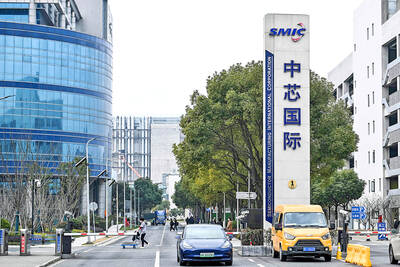At a century-old workshop in a quiet Tokyo neighborhood, craftsman Yuichi Hirose brushes dye across meticulously hand-cut stencils laid on fabric, using a traditional technique to produce contemporary kimono patterns.
Demand for the elaborate, elegant centerpiece of the Japanese wardrobe is in decline, but a handful of artisans and entrepreneurs, such as Hirose, 39, are trying to revive it.
“The kimono has become something that is very far removed from our daily lives,” said Hirose, who joined his family business after university.
He specializes in “Edo Komon” — a kimono pattern hand-dyed with a Japanese washi paper stencil, which dates back to the Edo period between the 17th and late 19th centuries.
It is a deeply traditional craft that requires great skill to master, “but we need to create something that is accepted in this modern time,” he said.
Hirose’s innovations include developing new designs to adorn the kimono, including tiny sharks or even skull motifs.
Once a standard of the Japanese wardrobe, the kimono is now often a garment reserved for special occasions, such as weddings and coming-of-age ceremonies, and is mostly worn by women.
They can be hugely expensive and women often hire experts to dress them because the outfit requires seemingly endless nipping, tucking and strapping.
The modern kimono industry peaked in 1975 with a market size of ¥1.8 trillion (US$17 billion), according to the Japanese Ministry of Economy, Trade and Industry.
However, by 2008 it had shrunk to ¥406.5 billion and further to just ¥278.5 billion in 2016, according to a survey conducted by Yano Research Institute.
“There are many hurdles” to buying a kimono, said Takatoshi Yajima, vice chairman of the Japan kimono promotion association, and a kimono manufacturer.
“It’s expensive. It’s difficult to wear. It’s too delicate to wash at home,” he said. “We need to make kimonos that are affordable and wearable. If we do that, I believe more young consumers will buy kimonos.”
Yajima has nearly doubled his number of customers in the past 15 years by selling more kimonos under the ¥100,000 price tag, well below the many thousands of US dollars a high-end piece can cost.
“The industry will grow if we can create a market in which as many people as possible will buy a kimono,” he said.
A complete kimono outfit starts with an undergarment known as a nagajuban, over which the kimono is layered, held in place with a thick obi belt and string.
The outfit is completed with tabi, ankle-high white socks divided at the big toe to allow feet to slip into thick-soled sandals called zori.
However, beyond the basic framework, designer Jotaro Saito said there should be room for experimentation.
“What’s fabulous, what’s unfashionable and what’s cool change every year. It’s wrong that kimonos don’t change even if everything else is changing,” said the Kyoto-based designer, whose work has been worn by US singer Lady Gaga. “Kimonos are not something old. Wearing a kimono is the coolest and the most fun thing.”
At Tokyo fashion week in March, Saito, who calls himself “a risk taker,” showcased kimonos for men and women, mixing traditional and unconventional motifs and colors.
“I want to present kimonos as a wardrobe in which people can truly feel joy,” he said.
And while demand for kimonos is falling among Japanese, services renting the garments to foreign visitors are booming.
Interest is expected to grow, with more tourists visiting Japan and looking for cultural experiences, the institute said.
Kahori Ochi serves about 500 foreign tourists a year at her kimono rental store in the trendy Harajuku area of Tokyo.
They pay about ¥9,000 to be dressed in a kimono worth about ¥300,000.
“Kimono is a piece of Japanese culture. I really wanted to experience that,” said Ruby Francisco, a Dutch tourist who rented a pale green kimono at Ochi’s shop.
“It’s special. It’s like an honor to wear,” the 33-year-old said, adding that she would post photographs of herself in the kimono on social media to show her friends.

SEMICONDUCTOR SERVICES: A company executive said that Taiwanese firms must think about how to participate in global supply chains and lift their competitiveness Taiwan Semiconductor Manufacturing Co (TSMC, 台積電) yesterday said it expects to launch its first multifunctional service center in Pingtung County in the middle of 2027, in a bid to foster a resilient high-tech facility construction ecosystem. TSMC broached the idea of creating a center two or three years ago when it started building new manufacturing capacity in the US and Japan, the company said. The center, dubbed an “ecosystem park,” would assist local manufacturing facility construction partners to upgrade their capabilities and secure more deals from other global chipmakers such as Intel Corp, Micron Technology Inc and Infineon Technologies AG, TSMC said. It

NO BREAKTHROUGH? More substantial ‘deliverables,’ such as tariff reductions, would likely be saved for a meeting between Trump and Xi later this year, a trade expert said China launched two probes targeting the US semiconductor sector on Saturday ahead of talks between the two nations in Spain this week on trade, national security and the ownership of social media platform TikTok. China’s Ministry of Commerce announced an anti-dumping investigation into certain analog integrated circuits (ICs) imported from the US. The investigation is to target some commodity interface ICs and gate driver ICs, which are commonly made by US companies such as Texas Instruments Inc and ON Semiconductor Corp. The ministry also announced an anti-discrimination probe into US measures against China’s chip sector. US measures such as export curbs and tariffs

The US on Friday penalized two Chinese firms that acquired US chipmaking equipment for China’s top chipmaker, Semiconductor Manufacturing International Corp (SMIC, 中芯國際), including them among 32 entities that were added to the US Department of Commerce’s restricted trade list, a US government posting showed. Twenty-three of the 32 are in China. GMC Semiconductor Technology (Wuxi) Co (吉姆西半導體科技) and Jicun Semiconductor Technology (Shanghai) Co (吉存半導體科技) were placed on the list, formally known as the Entity List, for acquiring equipment for SMIC Northern Integrated Circuit Manufacturing (Beijing) Corp (中芯北方積體電路) and Semiconductor Manufacturing International (Beijing) Corp (中芯北京), the US Federal Register posting said. The

India’s ban of online money-based games could drive addicts to unregulated apps and offshore platforms that pose new financial and social risks, fantasy-sports gaming experts say. Indian Prime Minister Narendra Modi’s government banned real-money online games late last month, citing financial losses and addiction, leading to a shutdown of many apps offering paid fantasy cricket, rummy and poker games. “Many will move to offshore platforms, because of the addictive nature — they will find alternate means to get that dopamine hit,” said Viren Hemrajani, a Mumbai-based fantasy cricket analyst. “It [also] leads to fraud and scams, because everything is now